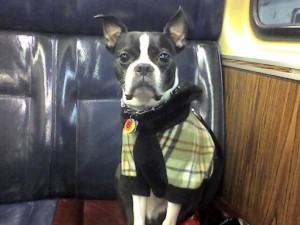 There are three distinct pieces to a voluntary behavior, called the ABCs.
There are three distinct pieces to a voluntary behavior, called the ABCs.
The “B” represents the behavior.
“A” is for Antecedent, which is anything present in the environment before a specific behavior. The A precedes the behavior.
“C” is for Consequence, which is the immediate result of the behavior.
Here’s an example of the ABCs of a voluntary behavior. A dog jumps up on a counter and gets food.
Dog sees and smells food on counter Dog jumps up Dog gets food.
A B C
- The A – food is on counter, dog has access to the counter area, dog is hungry
- The B is the behavior, which is any response to any stimulus.
- The C is the immediate consequence of the B.
Suppose you would like to reduce “jump up steal food off counter” behavior.
In order to change a voluntary behavior, we modify either the events / environment before the behavior (antecedent), or we modify the events or environment immediately after the behavior (consequence), or both.
You could modify the antecedents and the behavior would be less likely to occur. For Example: attach a leash or tether, place the dog outside of the area, teach the dog to sit or go to place while you make a sandwich, and so forth. Some of the changes could happen immediately, others require that you train your dog.
Now let’s take a look at a few consequences and how they might influence behavior.
Types of Consequences
If consequences are to have an effect on the preceding behaviors, consequences must occur during or immediately after behaviors. Consequences are grouped into two categories, reinforcers or punishers. For consequences to be considered reinforcers or punishers, their effects on behaviors must occur now and anytime in the future when the animal is presented with similar circumstances.
- Reinforcers increase behaviors.
- Punishers decrease behaviors.
Consequences can be added or subtracted.
- A consequence that is added or begins is called a positive consequence.
- A consequence that is subtracted or stopped is called a negative consequence.
There are four possible consequences for any given behavior. Two of the consequences will increase (or reinforce) the behavior, and the other two will decrease (or punish) the behavior.
- Positive Reinforcer – add or begin to increase behavior
- Positive Punisher – add or begin to decrease behavior
- Negative Punisher – subtract or remove to decrease behavior
- Negative Reinforcer – subtract or remove to increase behavior
Dog sees and smells food on counter Dog jumps up Dog gets food. In this example, the behavior of “dog jumps up” is being reinforced (assuming the dog likes the food). A stimulus is added and the consequence increases the behavior, therefore the consequence is a positive reinforcer.
Dog sees and smells food on counter Dog jumps up Dog gets squirted with water. In this example, the behavior of “dog jumps up” is being punished (assuming the dog dislikes being squirted with water). A stimulus begins and the consequence decreases the behavior, therefore the consequence is a positive punisher.
Dog sees and smells food on counter Dog jumps up Human makes food disappear. In this example, the behavior of jumping up is being punished (assuming the dog wants the food). A stimulus is subtracted and the consequence decreases the behavior, therefore the consequence is a negative punisher.
Dog on counter is being squirted with water Dog jumps off counter and onto floor Squirting of water is stopped. In this example, the behavior of “the dog being on the floor” is reinforced (assuming the dog dislikes being squirted with water). A stimulus is stopped and the consequence increases the behavior, therefore the consequence is a negative reinforcer. Negative reinforcers usually include escape and avoidance behavior.
Dog friendly training focuses on using positive reinforcement and negative punishment to teach our dogs desirable behaviors. Although we will use all four consequences, dog friendly training focuses on using positive reinforcement and negative punishment to teach our dogs desirable behaviors.
Alan J Turner – Dog Training in Memphis Collierville Germantown TN
How’s Bentley Aggressive Dog Seminar


